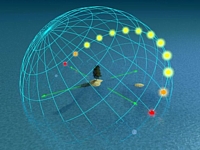1) The Sun always rises at one cardinal point and sets at the opposite point, just like the first stars at sunset and the last at dawn.
 Watch a sunrise and see where the Sun rises. Depending on your geographic location, this may be over a mountain, a plain, a river, etc., but it will always be from the same location if you see several sunrises in a row. Similarly, at the end of the day, the Sun will “set” at a different point, which will be the opposite point from which it appeared at sunrise, and this will invariably repeat itself as the days go by.
Watch a sunrise and see where the Sun rises. Depending on your geographic location, this may be over a mountain, a plain, a river, etc., but it will always be from the same location if you see several sunrises in a row. Similarly, at the end of the day, the Sun will “set” at a different point, which will be the opposite point from which it appeared at sunrise, and this will invariably repeat itself as the days go by.
By doing this exercise, you will not only notice that the Sun continues to "rise" at one point and "set" at the opposite point, but you will also be able to see it in the "rise" and "set" of one or more stars. When it gets dark, as sunlight becomes less and less, the stars begin to be seen; but if you look closely, you will notice that they seem to come from the same area where the Sun appeared at dawn. In the same way, when the Sun is about to appear at the next dawn, you will notice (in fact you will have noticed it all night) that these stars "set" at the opposite point, that is, in the same area where the Sun set at the previous dusk.
Preliminary conclusion: Cardinal points. This exercise, carried out over a few days, will quickly lead you to the conclusion that the main daytime celestial body (the Sun) and the numerous stars that can be seen shortly after sunset and just before dawn, follow an equivalent pattern of "rising" and "setting" sectors. This is a first approximation to the concept of cardinal points, the simplest way of orienting oneself in the sky.

